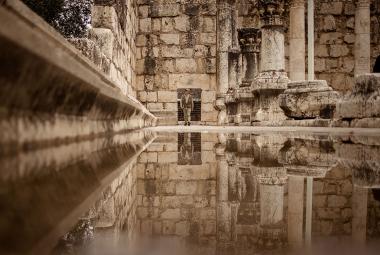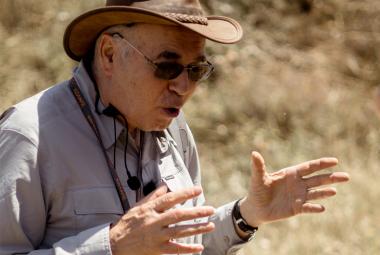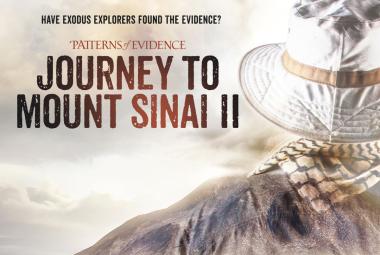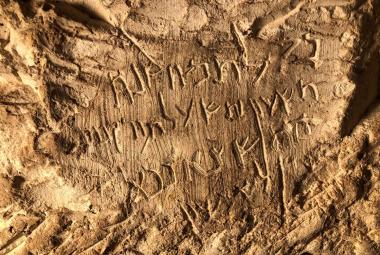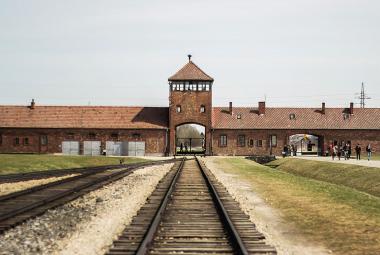[Ed. note: A few years ago, I was visited by a couple who revealed to us, with photos and their personal video, a spectacular discovery in Saudi Arabia. Unfortunately, this was one of these situations-surprisingly frequent in our strange enterprise-which we couldn't disclose publicly because certain lives would have been endangered. Fortunately, information has now come out in public sources that makes it possible to reveal what appears to solve one of the great mysteries in the Bible: Where is the real Mount Sinai?]
Bob Cornuke,1 a dear friend, visited us this past week and shared with us one of his recent adventures, which parallels several previous surreptitious visits to Saudi Arabia and clearly appears to corroborate some surprising discoveries. Bob Cornuke and Larry Williams managed - by means we will defer discussing here - to spend some time in Saudi Arabia and made it a point to check out an astounding theory about the Exodus in the Bible.
Most people understand that Mount Sinai is Jebel Musa, in the Sinai Peninsula, where the Monastery of St. Catherine's is located. Look at any competent Bible atlas, and it will probably include a "?" since that location is traditional, but speculative. There are a number of tenuous conjectures associated with this location and numerous books have been written suggesting alternative candidates, among them Jebel Helal further north in the Sinai Peninsula, or Jebel Serbal, in the south. Another candidate is Har Karkom, known to the Bedouins as Jebel Ideid, also in the north.2 None of these, all in the Sinai Peninsula, have any real archaeological evidence supporting them.
 However, Moses, when first exiled from Egypt, dwelt in Midian, at the base of Mt. Sinai. Midian was in the northwest corner of Saudi Arabia. The New Testament has always referred to Mount Sinai as being in Arabia.3
However, Moses, when first exiled from Egypt, dwelt in Midian, at the base of Mt. Sinai. Midian was in the northwest corner of Saudi Arabia. The New Testament has always referred to Mount Sinai as being in Arabia.3
An alternative route for the Exodus according to Cornuke and Williams is suggested in the accompanying map.
The Crossing Point
With scuba gear, they discovered a remarkable land bridge crossing the Strait of Tiran and the southern extremity of the Gulf of Aqaba, between Saudi Arabia and the Sinai Peninsula. Presently about 50 ft. underwater and several hundred yards in width, it drops several thousand feet on either side. The topography of the southern tip of the Sinai also fits the details of the Exodus narrative well.
Jabal al Lawz
Passing the bitter springs of Marah, they came to the mountain known as Jabal al Lawz. Moses kept sheep at Mt. Sinai (Exodus 2:21; 3:1ff); Bob and Larry found vegetation suitable for grazing. (The Israelites camped there 11 months.)
Jabal al Lawz rises about 8,000 feet above the desert. It consists of two snub-nosed peaks, with a natural amphitheater between them; the stage on which the most momentous drama in history had been played out. However, as one approaches closer to the mountain, one encounters military guards and a chain link fence, 15 feet high, topped with barbed wire and a sign, in Arabic and English:
ARCHAEOLOGICAL AREA WARNING:
"IT IS UNLAWFUL TO TRESPASS."
VIOLATORS ARE SUBJECT TO PENALTIES STIPULATED IN THE ANTIQUITIES REGULATIONS
PASSED BY ROYAL DECREE NO. M 26,
U 23.6.1392
Nevertheless, slipping past the guards at night and digging under the fence, Bob and Larry continued their adventure. Just south of the mountain, they found what they believe may have been the battlefield of Rephidim (Exodus 17:1, 8; 19:2; Numbers 33:14, 15), a dozen football fields in size.
They also found a large altar made up of extremely large, stacked boulders. On one of them they found pictographs of cattle, not sheep native to Arabia. These pictographs resembled the Apis bulls of Egypt. Could this have been the altar for the Golden Calf? (Cf. Exodus 32.)
As one reaches the higher elevations of Jabal al Lawz, the ground turns black, dark like obsidian; the rocks look almost like coal. (Yet when they're broken, they were actually granite.) They were not volcanic; they appeared as if scorched from above (Exodus 19:18). They even found an unusually large crevice in which a man could hide (Exodus 33:22?). They also found an old stream bed; "the brook that descended out of the mount" (Deuteronomy 9:21?).
At the base of the mount, they also found two huge rocks-perhaps 60 ft. long-wedged together, with a flat stone in the middle; possibly the altar of the Bible? (Exodus 20:24-26). Nearby, they also found the remains of the 12 pillars, all in a row, each one about 18 ft. in diameter, spaced 5 ft. apart (Exodus 24:4). Around the mountain, about 400 yards distant, they also found what appeared to be the boundary markers, the bounds set by Moses at the base of the mountain (Exodus 19:12, 21-23).
Needless to say, Bob and Larry are convinced that Jabal al Lawz is, indeed, the long-sought Mount Sinai of the Bible. We understand that a number of books will begin to assemble what is known about the site, and there has been talk of a television documentary.
An Arabian Museum
A national archaeological museum is presently under construction in Riyadh. While Saudi Arabia struggles to pay off its $55 billion Gulf War debt, the Kingdom is spending more than a billion riyals-about $266 million-on a new museum, to be completed by the year 2000. Officials believe it will attract international attention. "It will surprise the world." Why?
The mountain labeled Jabal al Lawz also boasts an unparalleled strategic vantage point for military applications as well. We also understand that new roads have been built, leading directly to Jabal al Lawz. Two towers, four stories high, have been erected: they are part of the FPS-117 radar systems for Site N-4 of the Peace Shield Air Defense System.
Excerpted in part from the article, "Mount Sinai's Deadly Treasure," by Howard Blum, Vanity Fair, February 1998, pp.74-90, which in turn was an excerpt from The Gold of Exodus: The Discovery of the True Mount Sinai, by Howard Blum, in publication by Simon and Schuster.
Notes:
- Bob Cornuke is a native Californian, a former football star at Fresno State, and a legendary member of the SWAT team of the Costa Mesa Police Department. A participant in numerous adventures, he is in the ministry and is presently associated with the Family Research Council.
- Emmanuel Anati, The Mountain of God, Rizzoli, New York, 1986.
- Galatians 4:25.

